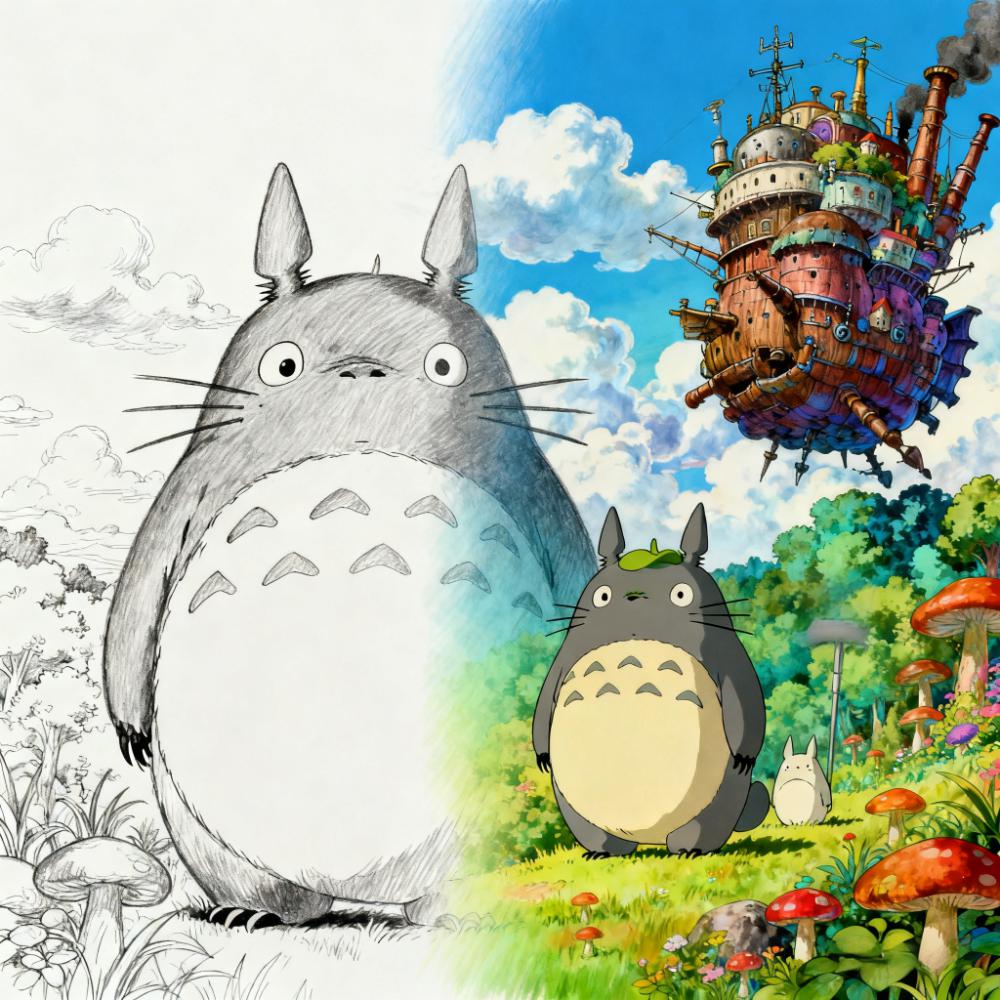Hand-drawn Foundation: Creating Line and Texture 'Breathing'
Ghibli style's foundation lies in hand-drawn lines full of 'breathing.' Unlike industrially produced uniform lines, Ghibli key animators' brushstrokes carry human temperature—Nausicaä's hair strands in 'Nausicaä of the Valley of the Wind' vary in thickness with movement, Shizuku Tsukishima's skirt pleat lines in 'Whisper of the Heart' carry hand-drawn slight tremors, even mechanical gears in 'Howl's Moving Castle' retain pencil-drawn original texture.
In process, key animators first use 2B pencils on animation paper for sketches, then use G-pens dipped in waterproof ink to outline contours, deliberately preserving line thickness variations and turn pauses, making characters and scenes instantly escape flatness.
In color filling stage, Ghibli's unique 'multi-layer coloring method' enhances hand-drawn texture: like 'Ponyo on the Cliff by the Sea,' first lay light pink foundation, then overlay with deep red dry brush, finally highlight hair edges with white; adjust brush intensity based on emotion—tense scenes use short strokes, gentle scenes use long strokes, using technique to carry emotion, making images become 'talking visual language.'
Color Language: Bidirectional Transformation of Natural Spectrum and Emotional Symbols
Ghibli's color design never copies reality but creatively transforms around themes. 'Princess Mononoke's' forest uses 'Miyazaki Green' (mix of olive green and blue-green) as base, showing mystery while implying crisis; human villages use earth yellow and ochre, creating color opposition between civilization and nature, strengthening the core of 'human-nature conflict.'
In lighting, often use warm-cold transformation to guide emotion: in 'Spirited Away,' daytime bathhouse uses warm yellow and ochre to create human world atmosphere; night switches to cold blue, dotted with purple and cyan, hinting at fantasy and danger. Like 'The Wind Rises' 'dream/reality' switching: reality uses low-saturation beige and gray-blue to carry heaviness, dreams use bright sky blue and warm yellow to symbolize ideals and lightness.
Dynamic Transformation: Sublimation from 'Physical Movement' to 'Life Rhythm'
Ghibli animation's dynamics transcend 'physical simulation,' reaching 'life rhythm.' The method lies in 'action observation' combined with 'exaggerated deformation.' Totoro's running originates from observing rabbits and bears—limb swing amplitude is increased, body undulation more obvious, making it powerful yet cute.
Magic scenes show more imagination: 'Howl's Moving Castle's' hair color change uses 'particle transformation'—first decomposing into countless thin lines, then converging into golden hair strands, interspersed with light points and flowing colors; 'Kiki's Delivery Service's' flight speed sense is achieved through 'background stretch/compression' coordinated with skirt direction and broom angle. Two-dimensional can also have three-dimensional spatial tension.
Scene Construction: Seamless Connection of 'Micro Realism' and 'Macro Fantasy'
'The Secret World of Arrietty' establishes credibility with 'micro realism': using magnifying glass to observe moss, dead leaves, insect wings, scaling them up for 'tea cup beds' and 'leaf curtains'; pulling camera back then using proportion exaggeration to create fantasy immersion, letting audience perceive world from Arrietty's perspective.
'Castle in the Sky' achieves seamless connection between mechanical and natural: lower part is detailed realistic floating mechanical island, upper part is tropical rainforest-style aerial garden. Through lighting transition, cold hard shadows and soft light gradually blend, metaphorizing 'technology-nature symbiosis.'
Intention Behind Technology: Using Craftsmanship to Guard 'Hand-drawn Temperature'
Facing digital wave of 'photo-realistic,' Ghibli insists on 'hand-drawn primary, digital auxiliary': using digital generation for repetitive elements, 3D assistance for perspective, but preserving hand-drawn brushstrokes and color-light judgment. 'The Boy and the Heron' uses '3D skeleton + hand-drawn flesh' to achieve complex spacetime's unified texture.
Ghibli's style transformation isn't showing off but serving stories: line breathing, color emotion, dynamic rhythm and scene reality ultimately focus on 'making audience feel life's temperature.' In an era pursuing 'speed and precision,' they remind us through every transformation: above technology, craftsmanship and love are still needed.
